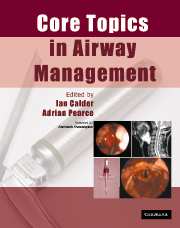Book contents
- Frontmatter
- Contents
- List of contributors
- Preface
- Acknowledgements
- List of abbreviations
- 1 Anatomy
- 2 Physiology of apnoea and hypoxia
- 3 Physics and physiology
- 4 Cleaning and disinfection of airway equipment
- 5 General principles
- 6 Maintenance of the airway during anaesthesia: supra-glottic devices
- 7 Tracheal tubes
- 8 Tracheal intubation of the adult patient
- 9 Confirmation of tracheal intubation
- 10 Extubation
- 11 Light-guided intubation: the trachlight
- 12 Fibreoptic intubation
- 13 Retrograde intubation
- 14 Endobronchial and double-lumen tubes, bronchial blockers
- 15 ‘Difficult airways’: causation and prediction
- 16 The paediatric airway
- 17 Obstructive sleep apnoea and anaesthesia
- 18 The airway in cervical trauma
- 19 The airway in cervical spine disease and surgery
- 20 The aspiration problem
- 21 The lost airway
- 22 Trauma to the airway
- 23 Airway mortality associated with anaesthesia and medico-legal aspects
- 24 ENT and maxillofacial surgery
- 25 Airway management in the ICU
- 26 The airway in obstetrics
- Index
9 - Confirmation of tracheal intubation
Published online by Cambridge University Press: 15 December 2009
- Frontmatter
- Contents
- List of contributors
- Preface
- Acknowledgements
- List of abbreviations
- 1 Anatomy
- 2 Physiology of apnoea and hypoxia
- 3 Physics and physiology
- 4 Cleaning and disinfection of airway equipment
- 5 General principles
- 6 Maintenance of the airway during anaesthesia: supra-glottic devices
- 7 Tracheal tubes
- 8 Tracheal intubation of the adult patient
- 9 Confirmation of tracheal intubation
- 10 Extubation
- 11 Light-guided intubation: the trachlight
- 12 Fibreoptic intubation
- 13 Retrograde intubation
- 14 Endobronchial and double-lumen tubes, bronchial blockers
- 15 ‘Difficult airways’: causation and prediction
- 16 The paediatric airway
- 17 Obstructive sleep apnoea and anaesthesia
- 18 The airway in cervical trauma
- 19 The airway in cervical spine disease and surgery
- 20 The aspiration problem
- 21 The lost airway
- 22 Trauma to the airway
- 23 Airway mortality associated with anaesthesia and medico-legal aspects
- 24 ENT and maxillofacial surgery
- 25 Airway management in the ICU
- 26 The airway in obstetrics
- Index
Summary
Introduction
Misplacement of a tracheal tube is a common complication. The tube may pass into the oesophagus or a main bronchus; this may occur at initial placement or the tube may migrate to one of these positions after movement of the patient. Oesophageal intubation is a preventable complication, which is lethal if unrecognized and which every anaesthetist must remain constantly on guard against.
Reasons for confirming tracheal intubation
The prompt recognition of misplacement is important because of the following:
• If not corrected, oesophageal placement will lead to:
– insufflation of the stomach when attempting to ventilate the lungs (in children this can lead to bradycardia and in all ages it increases the risk of regurgitation of stomach contents);
– hypoxia, brain damage and/or death.
• If not corrected, bronchial placement may lead to:
– hypoxaemia from shunting of blood;
– lung or lobar collapse;
– increased airway pressure and possible barotrauma/volutrauma.
• Consequently it is vital to:
– differentiate between a tube which has passed through the vocal cords from one which is in the oesophagus;
– determine that a tube through the cords is in the trachea and not in a main bronchus.
A variety of tests has been devised to do each of these. The tests reviewed here do not comprise a comprehensive list, but are commonly used, reliable or both. The reliability is evaluated according to estimates of the frequencies of false positives (related to specificity) and negatives (related to sensitivity) (Table 9.1). When reading publications on this topic it is important to be clear as to whether the authors are describing their results in terms of the ability of the test to identify tracheal or oesophageal placement.
- Type
- Chapter
- Information
- Core Topics in Airway Management , pp. 81 - 86Publisher: Cambridge University PressPrint publication year: 2005
- 1
- Cited by



